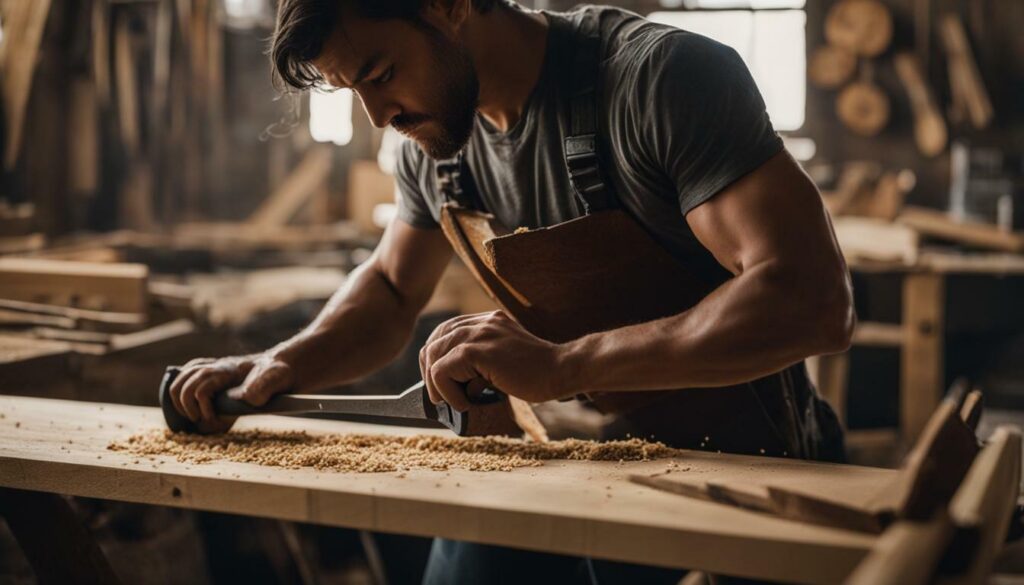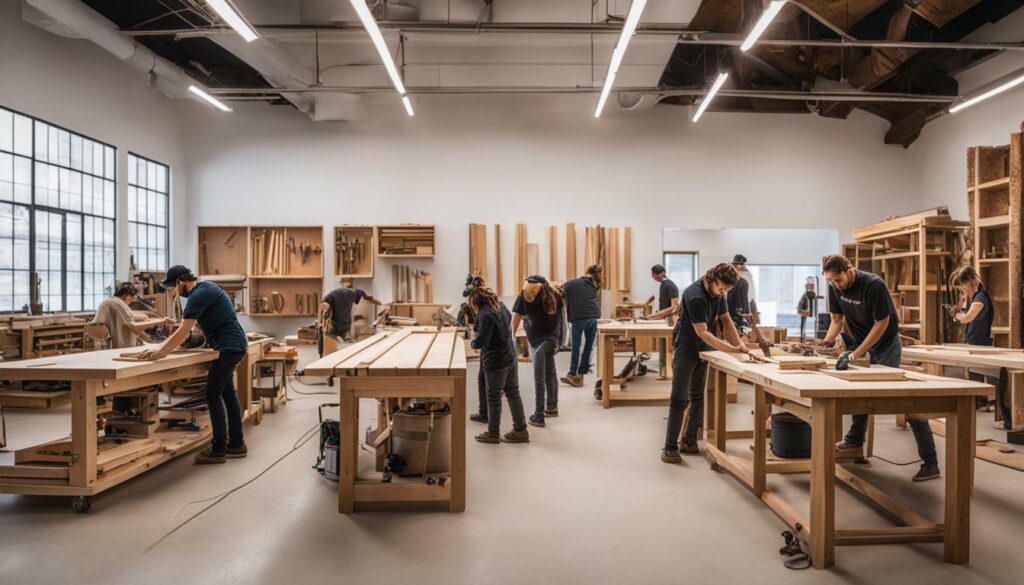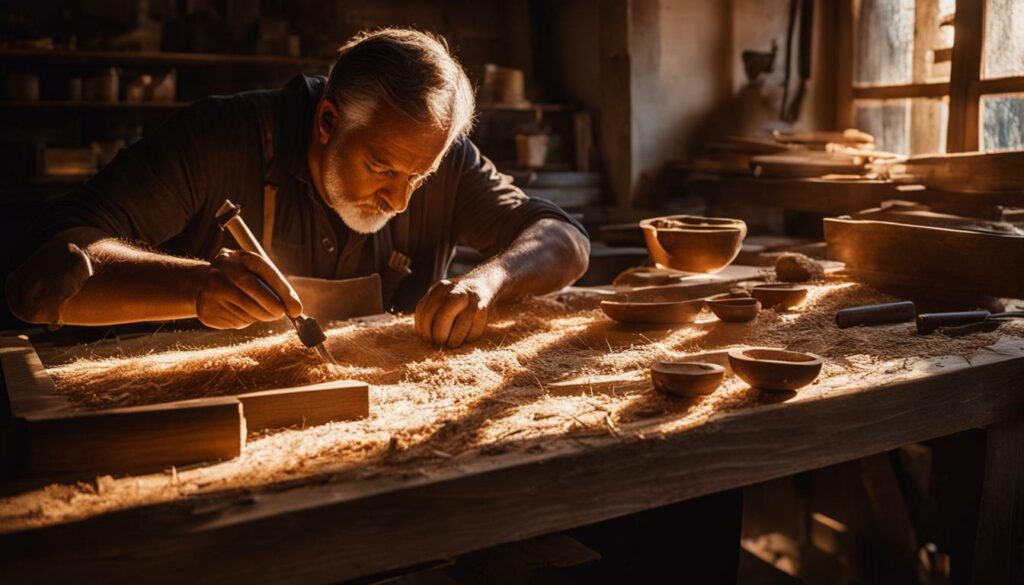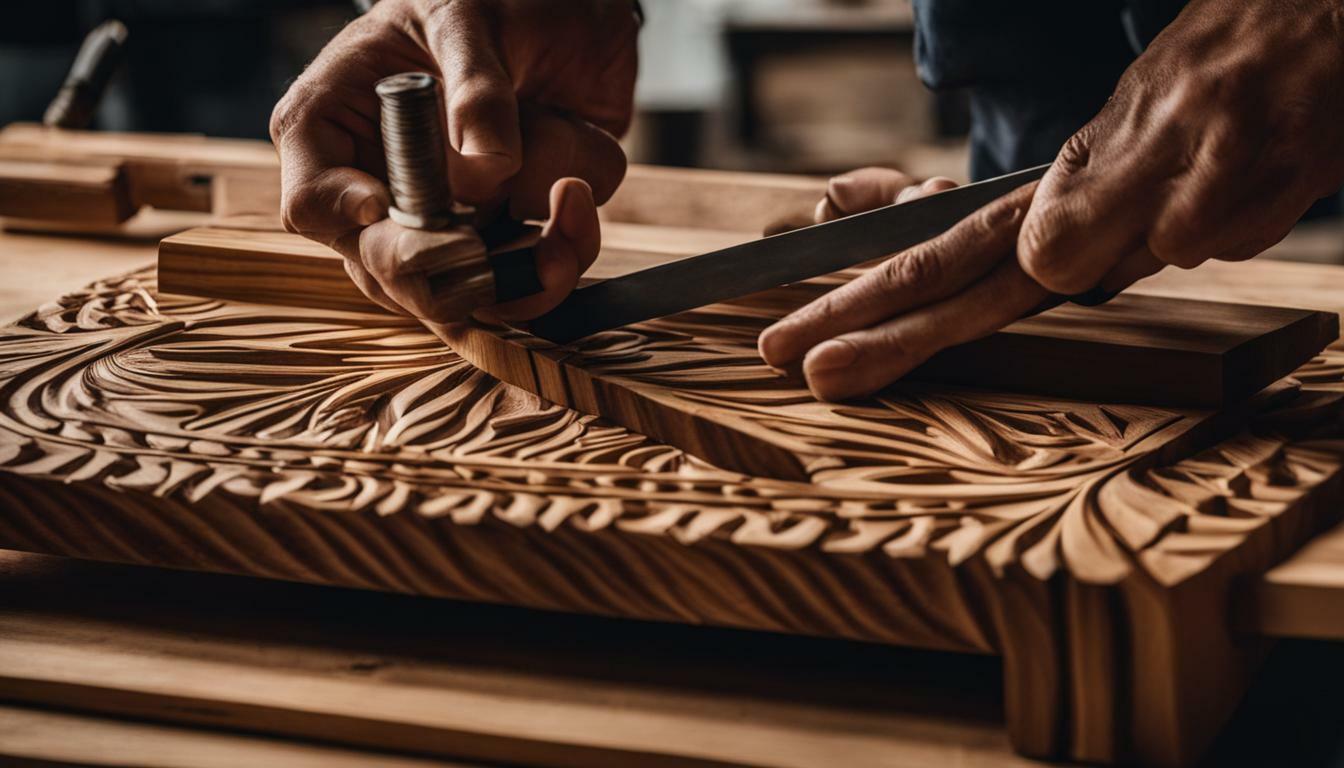Woodworking is more than just a craft – it’s a physical activity that can have numerous benefits for your body and overall well-being. When you engage in woodworking, you’re not only unleashing your creativity but also giving your muscles and mind a workout. So, put on your safety goggles, grab your tools, and let’s explore the physical benefits of woodworking!
- Woodworking is a physical activity that requires muscle, strength, accuracy, and self-discipline.
- Taking woodworking classes provides hands-on learning, student camaraderie, networking opportunities, and the chance to learn from experienced professionals.
- Embrace your unique path in woodworking and strive for personal improvement without comparing yourself to others.
- Woodworking is a rewarding and fulfilling craft that brings joy and satisfaction.
- Engaging in woodworking can have holistic wellness benefits for both your physical and mental health.
Woodworking and Physical Fitness: Sculpt Your Muscles!
If you’re looking for a unique way to stay active and get in shape, woodworking might just be the perfect fit for you! The craft of woodworking is not only a creative outlet but also a fantastic way to engage your body and improve your physical fitness. From sculpting your muscles to challenging your endurance, woodworking offers a full-body workout that can leave you feeling accomplished and energized.
Wood crafting is indeed a physical activity that requires strength, precision, and self-discipline. As you work with various tools and materials, you engage your muscles and develop both fine motor skills and overall coordination. Sawing, sanding, and hammering all contribute to building muscle tone and strength. Plus, the repetitive motions involved in woodworking help improve flexibility and joint mobility.
To illustrate the physical benefits of woodworking, let’s take a closer look at the different ways it can sculpt your muscles:
| Activity | Muscle Group |
|---|---|
| Cutting and shaping wood with a hand saw | Forearm, biceps, and deltoids |
| Sanding surfaces with sandpaper or power sander | Upper body, including triceps, pectorals, and shoulders |
| Carving intricate designs with chisels | Hands, wrists, and fingers |
| Assembling and lifting heavy pieces of furniture | Legs, core, and back |
As you can see, woodworking engages a wide range of muscle groups, providing a comprehensive workout for your body. So, while you’re crafting beautiful pieces of furniture or intricate designs, you’re also sculpting your muscles and improving your physical fitness.
Remember, woodworking requires physical exertion, so be sure to warm up before starting any project and listen to your body to prevent injuries. Stay hydrated, take breaks, and practice proper posture to ensure you get the most out of your woodworking workouts.

“The creation of something new is not accomplished by the intellect but by the play instinct.” – Carl Jung
Woodworking Tips:
- Start with simple projects and gradually increase the complexity as you build up your skills and endurance.
- Invest in ergonomic tools and equipment to minimize strain on your body during prolonged woodworking sessions.
- Join a woodworking class or community to learn from experienced woodworkers, share tips, and find inspiration.
- Don’t be afraid to make mistakes! Learning from them is an essential part of the woodworking journey.
- Enjoy the process and take pride in every piece you create. Woodworking is not just a physical activity; it’s a soul-enriching craft that brings joy and satisfaction.
So, if you’re ready to embark on a fulfilling and physically rewarding adventure, pick up those tools, unleash your creativity, and let woodworking sculpt your muscles and invigorate your mind!
Woodworking and Physical Endurance: Build Stamina and Focus
Woodworking isn’t just about strength and precision – it also demands endurance and mental fortitude. The art of working with wood requires sustained physical effort and the ability to stay focused for long periods of time. Whether you’re chiseling a intricate design or sawing through a thick piece of timber, woodworking provides a challenging workout for both your body and mind.
As you engage in woodworking, you’ll find that it builds your stamina and endurance over time. The repetitive motions involved in shaping wood can be physically demanding, especially when tackling larger projects. Moving heavy lumber, operating machinery, and employing hand tools all contribute to a full-body workout that strengthens muscles and improves cardiovascular health. It’s like going to the gym, but with the added bonus of creating something beautiful and functional.
Challenges and Reward:
Woodworking requires patience, determination, and mental endurance. The ability to stay focused and persevere through challenges is crucial to achieving quality results. It’s not uncommon to encounter setbacks or make mistakes along the way. However, these obstacles provide valuable learning opportunities and push you to develop resilience. The process of problem-solving and finding creative solutions strengthens not only your woodworking skills but also your ability to overcome obstacles in other areas of life.
Woodworking is like a marathon for the mind and body. It pushes you to your limits and rewards you with a sense of accomplishment like no other. Plus, the satisfaction of seeing your vision come to life with each carefully crafted piece is truly unbeatable.
Woodworking is not for the faint of heart. It is a craft that demands dedication, practice, and a willingness to push yourself to new levels. But, in return, it offers the opportunity to build physical endurance, hone your focus, and unleash your creativity. So, grab your tools, embrace the challenge, and let woodworking be your gateway to a stronger body and a sharper mind.

Don’t underestimate the physical demands of woodworking – it’s a comprehensive workout that targets various muscle groups. From the moment you pick up a chisel or a saw, you engage your arms, shoulders, and back as you slice through the wood with precision and control. The repetitive movements help build strength and endurance, not to mention the satisfying feeling of transforming raw materials into a beautiful piece of art.
But woodworking isn’t just about upper body strength. It also requires stability and balance as you navigate your way around the workshop, carefully measuring and aligning each piece. Your core muscles are constantly engaged as you maintain proper posture and control throughout the process. And let’s not forget about your legs – they play a crucial role in supporting your body as you stand, squat, and move around the workshop.
Whether you’re a novice or an experienced woodworker, you’ll quickly realize the full-body nature of this craft. It’s not just about working with your hands; it’s about engaging your entire body in a coordinated and purposeful manner. So the next time you pick up your tools, remember that you’re not just creating something beautiful – you’re also giving your body a well-deserved workout.
Table: Muscle Groups Engaged in Woodworking
| Muscle Group | Engagement |
|---|---|
| Arms | Chiseling, sawing, sanding |
| Shoulders | Pushing, pulling, lifting |
| Back | Posture maintenance, lifting heavy objects |
| Core | Body stability, balance |
| Legs | Standing, squatting, moving |
As you can see, woodworking is not only a creative outlet but also a way to stay physically active and fit. So the next time you find yourself immersed in your woodworking project, appreciate the fact that you’re giving your body a full-body workout while enjoying the process of creating something with your own hands. It’s a win-win situation for both your craftsmanship and your physical well-being.

Woodworking Education: Learning and Networking
Enrolling in woodworking classes opens up a world of learning opportunities, as well as the chance to connect with fellow woodworkers. Whether you’re a beginner looking to master the basics or a seasoned woodworker aiming to refine your skills, taking woodworking classes can provide valuable insights and experiences that you won’t find elsewhere.
Woodworking classes offer a hands-on learning environment where you can work directly with different tools and materials under the guidance of experienced instructors. This practical approach allows you to develop your woodworking skills in a supportive setting, where you can ask questions, receive feedback, and gain confidence in your abilities.
Moreover, woodworking classes provide excellent networking opportunities. You’ll have the chance to meet fellow woodworkers who share your passion for the craft. These connections can lead to invaluable collaborations, mentorships, and friendships within the woodworking community. It’s a chance to learn from others, exchange ideas, and be inspired by the diverse perspectives and experiences that each woodworker brings to the table.
Remember, woodworking education should be enjoyable. It’s important not to be overly critical of your own work. Instead, embrace your unique path and strive for personal improvement. Woodworking is a craft that allows for continuous learning and growth. As the saying goes, “Every master was once a beginner.” So, don’t compare yourself to others, but focus on your own progress and the joy that woodworking brings you.

| Benefits of Woodworking Classes: |
|---|
| Hands-on learning experience |
| Guidance from experienced instructors |
| Networking opportunities with fellow woodworkers |
| Collaborations, mentorships, and friendships |
| Opportunity to learn from mistakes and strive for personal improvement |
| Enjoyment and personal fulfillment in the craft |
Striving for Personal Improvement: Embrace Your Unique Path
In woodworking, it’s crucial to focus on personal growth and improvement rather than comparing yourself to others. Each craftsman has their own unique style, skills, and artistic vision. Instead of being consumed by comparisons, embrace your individuality and use it as a catalyst for personal improvement. Remember, mistakes are a natural part of the learning process. They offer valuable lessons and opportunities for growth.
When faced with a challenging project or a mistake, don’t be discouraged. Take a step back, assess the situation, and find creative solutions. This creative problem-solving not only enhances your woodworking skills but also fosters resilience and adaptability. Continuously seeking new techniques, materials, and design inspirations will expand your knowledge and push the boundaries of your craftsmanship.
One way to facilitate personal growth in woodworking is by taking classes. These hands-on learning experiences provide valuable insights, guidance from experienced professionals, and the opportunity to collaborate and learn from fellow woodworkers. Woodworking classes offer a supportive and encouraging environment where mistakes are seen as stepping stones to improvement, rather than failures.
| Woodworking Education Benefits: |
|---|
| 1. Hands-on learning experiences |
| 2. Guidance from experienced professionals |
| 3. Collaboration and networking opportunities |
| 4. Supportive and encouraging environment |
Remember, your woodworking journey is unique to you. Embrace your own path, learn from your mistakes, and celebrate your successes. Every piece you create is a testament to your growth and dedication. With each project, you’ll find yourself improving, gaining confidence, and finding new joy in the craft. So, grab your tools, don your apron, and let your creativity soar in the world of woodworking!

Woodworking is not just a craft—it’s a joyful pursuit that can bring immense satisfaction and a sense of accomplishment. Engaging in woodworking can ignite a spark of creativity within you, allowing you to transform raw materials into beautiful and functional pieces.
As you work with your hands, shaping and molding wood, you’ll discover a deep sense of fulfillment that comes from bringing your ideas to life. Whether you’re crafting a custom piece of furniture or carving intricate designs, each stroke of the saw or chisel is an opportunity to express your unique vision. Woodworking allows you to leave your mark on the world, leaving behind tangible creations that will be cherished for years to come.

But woodworking isn’t just about the end result—it’s about the journey. The process itself can be incredibly rewarding, as you overcome challenges, learn new techniques, and expand your skill set. Woodworking requires patience, precision, and perseverance, pushing you to constantly push the boundaries of your abilities. The joy of woodworking comes not only from the final product but also from the growth you experience along the way.
Embrace the Imperfections
Woodworking teaches us the value of embracing imperfections. Each knot, grain pattern, or small flaw in the wood adds character and uniqueness to your creation. It’s a reminder that beauty lies in imperfection and that mistakes are opportunities for growth. Don’t be afraid to make mistakes or to deviate from traditional norms—this is where true innovation and personal style can emerge. The joy of woodworking lies in the freedom to experiment, explore, and create something that is truly yours.
| Woodworking as a Joyful Pursuit: Find Satisfaction in the Craft | Summary: |
|---|---|
| “Woodworking is not just a craft—it’s a joyful pursuit that can bring immense satisfaction and a sense of accomplishment.” | In woodworking, you can find creativity and happiness as you shape wood into beautiful and functional pieces. The journey of woodworking is just as rewarding as the end result, with each stroke of the saw or chisel pushing your skills to new heights. Embracing imperfections and deviating from traditional norms allows for personal growth and innovation. Woodworking brings joy and fulfillment, leaving a lasting legacy through tangible creations. |
Uncover the Physical and Mental Benefits: Holistic Wellness
Engaging in woodworking can have a profound impact on your overall well-being, promoting both physical and mental health. The craft of woodworking not only provides a creative outlet but also offers numerous benefits that contribute to your holistic wellness. From physical fitness to mental clarity, here’s how woodworking can enhance your well-being.
Physical Health
Woodworking is a hands-on activity that requires strength, dexterity, and coordination. By working with tools and materials, you engage your muscles and improve your physical fitness. The physical demands of woodworking provide a full-body workout, helping to sculpt your muscles and improve your stamina. It also promotes better hand-eye coordination and enhances your motor skills, which are vital for maintaining overall physical health.
Additionally, woodworking can be a great way to relieve stress and tension. As you focus on shaping wood and creating something with your own hands, you can experience a sense of mindfulness and relaxation. This can help reduce anxiety and promote a more balanced state of mind.
Mental Well-being
Woodworking is not just about creating physical objects; it also stimulates your mind and promotes mental well-being. When you engage in woodworking projects, you challenge yourself to solve problems and think critically. This mental stimulation can help improve cognitive function and enhance your focus and concentration.
Moreover, woodworking can be a fulfilling and rewarding activity. As you see your creations come to life, you gain a sense of accomplishment and satisfaction. Woodworking encourages self-expression and allows you to tap into your creative side, which can boost your self-esteem and overall mental well-being.
Incorporating woodworking into your life can lead to a more balanced and fulfilling lifestyle. Not only does it provide physical and mental benefits, but it also offers a sense of joy and satisfaction. So why not pick up a chisel, embrace the craft of woodworking, and nurture your body and mind?

| Physical Benefits | Mental Benefits |
|---|---|
| Improves physical fitness and strength | Enhances cognitive function and focus |
| Sculpts muscles and improves stamina | Boosts self-esteem and creative expression |
| Promotes better hand-eye coordination | Reduces stress and anxiety |
Conclusion: Woodworking – a Craft that Nurtures the Body and Mind
Woodworking goes beyond just being a craft—it’s a physical activity that nurtures both the body and mind, providing countless benefits for enthusiasts. The act of working with wood requires focused energy and engages all senses, demanding muscle, strength, accuracy, and self-discipline. Whether you’re a beginner or an experienced woodworker, taking woodworking classes can be incredibly valuable. Not only do they offer hands-on learning and the chance to improve your skills, but they also provide a supportive community of like-minded individuals.
Woodworking education is not about being overly critical of your own work. Instead, it’s about embracing your own unique path and continuously striving for personal improvement. It’s essential to remember that everyone makes mistakes and that these mistakes can serve as valuable learning opportunities. By aiming for your personal best and learning from these experiences, you can grow as a woodworker and hone your craft.
Woodworking is a rewarding and fulfilling pursuit that brings joy and satisfaction to practitioners. The sense of accomplishment that comes from creating something with your own hands is truly unmatched. Each project completed brings a sense of pride and fulfillment, and the process itself can be both relaxing and meditative. Woodworking allows you to escape the stresses of everyday life and immerse yourself in a world of creativity, craftsmanship, and self-expression.
Furthermore, woodworking nurtures both the body and mind. It provides a form of exercise that engages the entire body, improving physical endurance, strength, and coordination. The mental benefits of woodworking should not be overlooked either—it promotes focus, concentration, and problem-solving skills. The combination of physical and mental engagement makes woodworking a holistic activity that contributes to overall wellness.
FAQ
Q: Is woodworking a physical activity?
A: Absolutely! Woodworking requires focused energy and engages all your senses. It demands muscle, strength, accuracy, and self-discipline. It’s more than just a passive pastime – it’s an active pursuit that exercises your whole body and mind.
Q: What are the physical benefits of woodworking?
A: Woodworking can contribute to physical fitness and sculpt your muscles. It requires physical exertion and can help build stamina and improve focus. It’s like a full-body workout that engages your entire body.
Q: Should I take woodworking classes?
A: Taking woodworking classes can be extremely valuable, no matter your skill level. It offers hands-on learning, the chance to connect with other students, networking opportunities, and the opportunity to learn from experienced professionals. Plus, it’s just plain fun!
Q: How can I strive for personal improvement in woodworking?
A: Embrace your own unique path and don’t compare yourself to others. Aim for your personal best and continuously learn from your mistakes. Woodworking is all about personal growth and improvement, so enjoy the process!
Q: Can woodworking bring joy and satisfaction?
A: Absolutely! Woodworking is a rewarding and fulfilling craft that can bring immense joy and satisfaction. The sense of accomplishment you feel when completing a project is incomparable. So get ready to experience the joy of woodworking!
Can Woodworking Be a Physically Demanding Career?
Can woodworking be a physically demanding career? The woodworking career viability explored reveals that it indeed requires physical stamina, strength, and dexterity. Woodworkers often engage in heavy lifting, operating power tools, and spending long hours on their feet. Despite the physical demands, the satisfaction of creating beautiful pieces makes it a rewarding profession.

